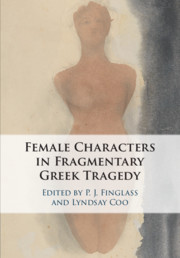Book contents
- Female Characters in Fragmentary Greek Tragedy
- Female Characters in Fragmentary Greek Tragedy
- Copyright page
- Contents
- Notes on Contributors
- Preface
- Abbreviations
- 1 Introduction
- Part I Themes
- Part II Plays
- 7 Dancing on the Plain of the Sea
- 8 Europa Revisited
- 9 When Mothers Turn Bad
- 10 The Music One Desires
- 11 Fragmented Self and Fragmented Responsibility
- 12 Female Agency in Euripides’ Hypsipyle
- 13 Making Medea Medea
- Bibliography
- General Index
- Index of main female characters discussed
13 - Making Medea Medea
from Part II - Plays
Published online by Cambridge University Press: 11 June 2020
- Female Characters in Fragmentary Greek Tragedy
- Female Characters in Fragmentary Greek Tragedy
- Copyright page
- Contents
- Notes on Contributors
- Preface
- Abbreviations
- 1 Introduction
- Part I Themes
- Part II Plays
- 7 Dancing on the Plain of the Sea
- 8 Europa Revisited
- 9 When Mothers Turn Bad
- 10 The Music One Desires
- 11 Fragmented Self and Fragmented Responsibility
- 12 Female Agency in Euripides’ Hypsipyle
- 13 Making Medea Medea
- Bibliography
- General Index
- Index of main female characters discussed
Summary
The influence of the extant plays has been so immense and far-reaching that it is easy to forget that other tragic versions of these characters existed. This is true above all in the case of Euripides’ Medea, whose terrible, tortured act of infanticide is to many modern readers and audiences the single defining aspect of her tragic characterisation. The final chapter destabilises this preconception by drawing together evidence for the full range of tragic Medeas, including a play in which she is not guilty of the act that has come to define her, the killing of her own children. Wright recovers a more accurate picture of Medea on the tragic stage, and suggests that what ‘made Medea Medea’ for the ancient audiences was not her infanticide, but rather the sheer range and malleability of stories in which she featured. This survey offers an important corrective to widespread conceptions of this iconic figure, and powerfully demonstrates how the legacy of a single surviving version has distorted our understanding of the kinds of female characters with which ancient tragic audiences would have been familiar.
Keywords
- Type
- Chapter
- Information
- Female Characters in Fragmentary Greek Tragedy , pp. 216 - 243Publisher: Cambridge University PressPrint publication year: 2020
- 1
- Cited by

